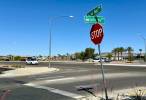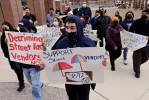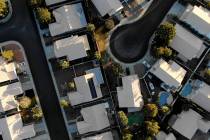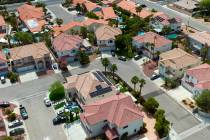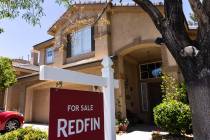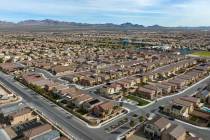Contrary to census data, Las Vegas no ghost town

The new census numbers say Las Vegas is practically a ghost town.
When the housing bubble blew and the economy sank, thousands of Southern Nevadans pulled up stakes and abandoned their homes, leaving one in seven houses a vacant shell.
That’s what the numbers say, anyway.
But as is often the case with statistics, the numbers don’t tell the whole story, local demographers and housing experts say.
"There’s no doubt it’s ground zero in the foreclosure situation, but to imply that it’s a ghost town … that’s not true," said Dennis Smith of Home Builders Research, a Las Vegas-based real estate research firm.
The numbers went public in February with the first major release of data collected during the 2010 census. Along with statistics on population and racial demographics, the census released what it calls occupancy data, which is a tally of total "housing units" and how many are vacant.
The numbers showed nearly 125,000 empty housing units in Clark County, which pushed the county’s vacancy rate to 14.9 percent and drove the statewide numbers to 14.3 percent, 11th worst in the nation.
States worse off than Nevada included Florida, Arizona, Vermont and Maine, the worst with a 22.8 percent vacancy rate.
The issue, local demographers say, is how the Census Bureau defines a housing unit. The definition includes just about everything, from single-family homes and apartments to weekly motels and time-share condominiums. It also includes empty homes that are for rent or for sale.
Jon Wardlaw, assistant planning manager for Clark County, said he believes the local vacancy numbers have been inflated with the proliferation of high-rise condo-hotels and vacation time shares that get counted as housing units but are not primary residences.
"Who lives in a time share? You can’t. So is it a hotel or something else?" said the demographer, whose own calculations put the county home vacancy rate at about 8 percent.
EMPTY VACATION HOMES
That phenomenon is apparent with a glance at a list of the most vacant block groups in Las Vegas. Census block groups are areas that contain 600 to 3,000 people, with an optimal size of 1,500 people.
Topping the list with a 98 percent vacancy rate is the south end of the Strip, between Spring Mountain Road and Tropicana Avenue. According to the census, 6,682 of that area’s 6,803 housing units were vacant.
Next on the list is the north end of the Strip, between Spring Mountain and Sahara Avenue, with a 76 percent vacancy rate for its 2,196 housing units.
Several other block groups near the top of the list are largely industrial areas with some weekly motels or high-rise condominiums. And all those empty vacation homes and other seasonal or temporary dwellings get counted the same as a vacant home in foreclosure.
So, while resort-destination states such as Nevada and Florida have been hit hard by the foreclosure crisis, their vacancy numbers are likely inflated by large numbers of homes occupied only part of the year or as secondary homes.
In his blog, Census Bureau Director Robert Groves noted the misunderstanding of his agency’s occupancy data and warned about using it to make conclusions.
"Using the delivered total vacancy counts that include seasonal, recreational or occasional use vacant units can mislead a user who wants to measure the impact of the housing crisis in such an area," he wrote on Feb. 10.
SKEWED DATA
Demographers and housing researchers realize the distinction, but many others don’t. Media reports have touted the numbers and linked them to the foreclosure crisis in Nevada.
"It bothers me. The data is skewed," said Smith, who recalled a recent visit by out-of-town investors who asked to see the neighborhoods-turned-ghost towns they had heard about.
Smith had to let them down, because the picture they came in with is a myth.
"It reinforces what some people would like to believe," Smith said of the high vacancy numbers. "There are a lot of people who would like to see Las Vegas struggle because it has so much success."
Beyond creating a bad impression of Southern Nevada, the census numbers could potentially be misused by home builders, government agencies and banks in decision making, said Robert Potts, assistant director of the Center for Business and Economic Research at the University of Nevada, Las Vegas.
"What I found most surprising was how easily the numbers can be misinterpreted without really understanding what’s behind the numbers," Potts said. "That can really lead you to the wrong conclusions."
But just because the census data might be misleading doesn’t mean the Las Vegas housing market is in good shape.
NUMBERS VARY
Local researchers believe the number of empty homes is in the 30,000 to 80,000 range, a far cry from the 125,000 in the census data. But even with the most conservative number, it will take several years at the current sales pace for those homes to be occupied, Potts said.
While most housing market researchers don’t use the census data in their analyses, demographers rely on the decennial census to determine a key figure to use in population estimates through the next decade.
To get that figure — the number of people per household — demographers will wait for more detailed census data in coming months that will allow them to exclude time shares and other nontraditional housing units from their calculations, Wardlaw said.
Wardlaw’s vacancy calculations use county land records and account information from NV Energy to estimate how many homes are empty. His most recent numbers from July put the single-family home vacancy rate at 7.2 percent and the multifamily home rate at 11 percent.
Both of those rates are roughly double what they were during the boom years in the early 2000s.
In the future, Wardlaw said he hoped the Census Bureau would change its definition so nontraditional housing units weren’t counted the same as traditional homes, but he conceded that they might just agree to disagree.
State demographer Jeff Hardcastle has been in contact with Census Bureau officials about the issue.
For now, though, he and other demographers will have to be patient while waiting for the more detailed census data that will provide a more accurate picture of the housing situation, he said.
"We’ve got to be careful not to throw the baby out with the bath water," Hardcastle said. "We don’t want to say the census is totally wrong. We don’t want to say the census is totally right. What I’m saying is we don’t know."
Contact reporter Brian Haynes at bhaynes@reviewjournal.com or 702-383-0281.



